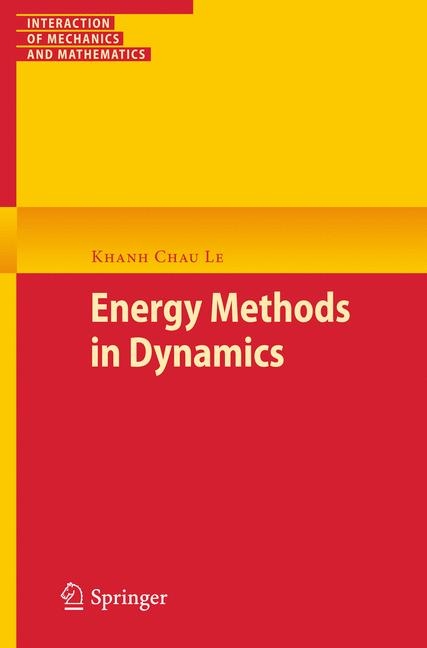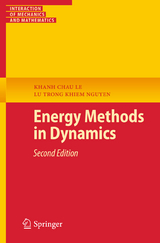Energy Methods in Dynamics
Seiten
2011
|
2012
Springer Berlin (Verlag)
978-3-642-22403-4 (ISBN)
Springer Berlin (Verlag)
978-3-642-22403-4 (ISBN)
- Titel erscheint in neuer Auflage
- Artikel merken
Zu diesem Artikel existiert eine Nachauflage
Energy Methods in Dynamics helps students gain a firm grasp of the fundamental principles from which governing equations can be derived, and the adequate mathematical methods to solve them. The textbook is written with a systematic and intensive use of Hamilton's variational principle.
The above examples should make clear the necessity of understanding the mechanism of vibrations and waves in order to control them in an optimal way. However vibrations and waves are governed by differential equations which require, as a rule, rather complicated mathematical methods for their analysis. The aim of this textbook is to help students acquire both a good grasp of the first principles from which the governing equations can be derived, and the adequate mathematical methods for their solving. Its distinctive features, as seen from the title, lie in the systematic and intensive use of Hamilton's variational principle and its generalizations for deriving the governing equations of conservative and dissipative mechanical systems, and also in providing the direct variational-asymptotic analysis, whenever available, of the energy and dissipation for the solution of these equations. It will be demonstrated that many well-known methods in dynamics like those of Lindstedt-Poincare, Bogoliubov-Mitropolsky, Kolmogorov-Arnold-Moser (KAM), and Whitham are derivable from this variational-asymptotic analysis.
This book grew up from the lectures given by the author in the last decade at the Ruhr University Bochum, Germany. Since vibrations and waves are constituents of various disciplines (physics, mechanics, electrical engineering etc.) and cannot be handled in a single textbook, I have restricted myself mainly to vibrations and waves of mechanical nature. The material of this book can be recommended for a one year course in higher dynamics for graduate students of mechanical and civil engineering. For this circle of readers, the emphasis is made on the constructive methods of solution and not on the rigorous mathematical proofs of convergence. As compensation, various numerical simulations of the exact and approximate solutions are provided which demonstrate vividly the validity of the used methods. To help students become more proficient, each chapter ends with exercises, of which some can be solved effectively by using Mathematica.
The above examples should make clear the necessity of understanding the mechanism of vibrations and waves in order to control them in an optimal way. However vibrations and waves are governed by differential equations which require, as a rule, rather complicated mathematical methods for their analysis. The aim of this textbook is to help students acquire both a good grasp of the first principles from which the governing equations can be derived, and the adequate mathematical methods for their solving. Its distinctive features, as seen from the title, lie in the systematic and intensive use of Hamilton's variational principle and its generalizations for deriving the governing equations of conservative and dissipative mechanical systems, and also in providing the direct variational-asymptotic analysis, whenever available, of the energy and dissipation for the solution of these equations. It will be demonstrated that many well-known methods in dynamics like those of Lindstedt-Poincare, Bogoliubov-Mitropolsky, Kolmogorov-Arnold-Moser (KAM), and Whitham are derivable from this variational-asymptotic analysis.
This book grew up from the lectures given by the author in the last decade at the Ruhr University Bochum, Germany. Since vibrations and waves are constituents of various disciplines (physics, mechanics, electrical engineering etc.) and cannot be handled in a single textbook, I have restricted myself mainly to vibrations and waves of mechanical nature. The material of this book can be recommended for a one year course in higher dynamics for graduate students of mechanical and civil engineering. For this circle of readers, the emphasis is made on the constructive methods of solution and not on the rigorous mathematical proofs of convergence. As compensation, various numerical simulations of the exact and approximate solutions are provided which demonstrate vividly the validity of the used methods. To help students become more proficient, each chapter ends with exercises, of which some can be solved effectively by using Mathematica.
I Linear theory.- 1 Single oscillator.- 2 Coupled oscillator.- 3 Continuous oscillator.- 4 Linear waves.- II Nonlinear theory.- 5 Single oscillator.- 6 Forced oscillator.- 7 Coupled oscillator.- 8 Nonlinear waves.
| Erscheint lt. Verlag | 2.10.2011 |
|---|---|
| Reihe/Serie | Interaction of Mechanics and Mathematics |
| Zusatzinfo | X, 294 p. 142 illus. |
| Verlagsort | Berlin |
| Sprache | englisch |
| Maße | 155 x 235 mm |
| Gewicht | 455 g |
| Themenwelt | Technik ► Maschinenbau |
| Schlagworte | Dissipation • Energy • Hamilton's Variational Principle and its Generalization • Hamilton’s Variational Principle and its Generalization • Variational-Asymptotic Method |
| ISBN-10 | 3-642-22403-2 / 3642224032 |
| ISBN-13 | 978-3-642-22403-4 / 9783642224034 |
| Zustand | Neuware |
| Haben Sie eine Frage zum Produkt? |
Mehr entdecken
aus dem Bereich
aus dem Bereich
Buch | Softcover (2023)
Springer Vieweg (Verlag)
24,99 €
Lösungshinweise, Ergebnisse und ausführliche Lösungen
Buch | Softcover (2023)
Springer Vieweg (Verlag)
26,99 €
Normung, Berechnung, Gestaltung
Buch | Softcover (2023)
Springer Vieweg (Verlag)
39,99 €





